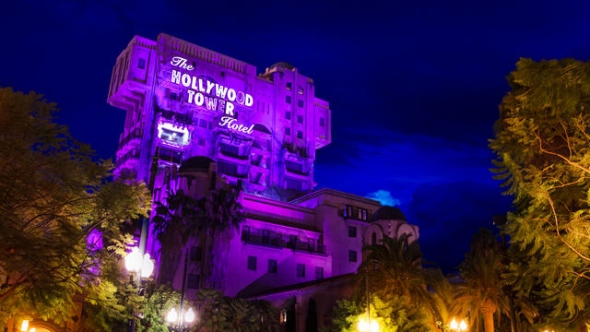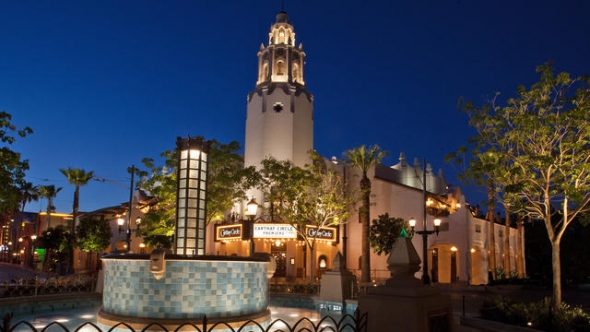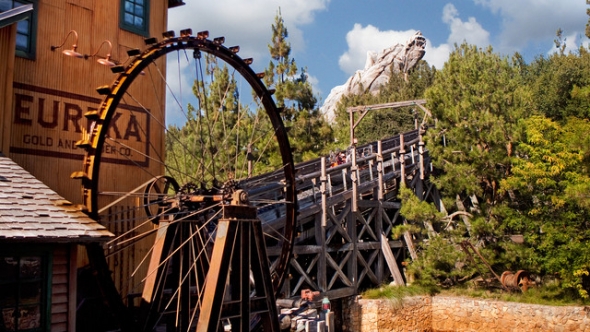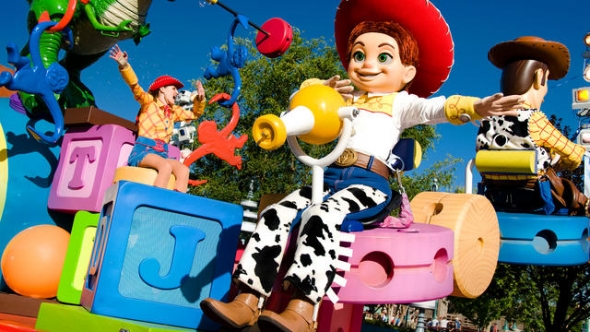A shaky start made worse by historical events
Image: Disney
Theming for a California-based theme park was assuredly a strange series of conversations for Imagineers. So much of the landscape of the state is beautiful and mountainous. Disney park builders had proven time and again that they can achieve both the former and the latter if given enough time and resources. The catch with Disney's California Adventure involved the tight purse strings. Imagineers faced unique restraints since $600 million wasn’t much for an entire theme park campus. As a point of comparison, that’s about 10 percent of what Disney recently spent for Shanghai Disneyland. Imagineers ARE miracle workers, but as Miracle Max says, when you rush a miracle man, you get rotten miracles.
The opening day attractions for Disney California Adventure run the gamut from amazing to breathtakingly terrible. Unquestionably the best combination of California theme and novel attraction was Soarin’ Over California, a sublime simulation of several hallmarks from the Golden State. That one ride, later duplicated in other Disney theme parks across the world, basically justified the entire expansion from my perspective. It’s one of the greatest triumphs Disney’s experienced since the death of its founder.
Several other attractions from opening day still operate now. Those include California Screamin’ (the best pure roller coaster at any Disney theme park), Grizzly River Run, the Sun Wheel (now known as Mickey’s Fun Wheel), Jumpin’ Jellyfish, King Triton’s Carousel, and Golden Zephyr. Five of those rides exemplify why the public turned on the Disneyland expansion.
Image: Disney
Word leaked that Disney didn’t bother constructing their own attractions. Instead, they had ordered prefabricated rides from other companies, modifying them at the end to “plus” them up to Disney standards. Customers didn’t view this as the proper interpretation of Disney standards. Instead, they saw a company cutting costs by stamping the Disney logo on someone else’s work. Even worse, many of the rides they’d acquired reeked of carnivals and amusement parks. They specifically went against the grain of Disney’s corporate heritage. Fanatics expressed outrage that Disney had chosen to diminish its own culture.
On February 8, 2001, Disneyland California Adventure opened its gates for the first time. Disney insiders were ambitious with their attendance projections. In point of fact, they were laughably high. When Disneyland itself opened in 1955, guests swarmed the park by hook or by crook. Park planners anticipating 7,000 guests felt overwhelmed when 27,000 stormed the gates. Disney California Adventure was the polar opposite of that.
Disney projected attendance at least matching Disneyland’s on opening day in 1955. They allowed for 35,000 guests if it proved especially popular. They were off by a factor of five. This is the theme park equivalent of inviting 250 people to your party, only to have your best friend attend. At a time when 12.3 million guests visited Disneyland, only 5 million entered Disney California Adventure. And it was LITERALLY ACROSS THE STREET. Few guests bothered to give the second gate a chance, and those who did walked away dissatisfied. Park surveys, frantically thrown together after months of an empty park, revealed that only one out of every five guests attending Disney California Adventure felt it was a good value.
Image: Disney
That’s only part of the story, though. A second unpredictable event destroyed any hope the Disneyland Resort expansion had of succeeding early on. While the park’s first six months were already shaky, the seventh month was when a black swan event devastated all of America, damaging its economic strength in the process. On September 11, 2001, terrorists attacked the World Trade Center. In the wake of their horrific actions, the New York Stock Exchange experienced its worst single day loss in history to that point, and travel ground to a halt. Disney California Adventure was already facing negative buzz for the quality of its attractions. It certainly couldn’t overcome the combination of its pure reception and an economic recession. 9/11 undeniably prolonged the struggles of the second gate at Disneyland, but Disney had already done enough harm on its own due to its cost-cutting measures.
Low cost versus high expectations
Image: Disney
By way of explanation for the negative reception, analysts noted that Disney cut corners as much as possible to keep down the construction costs on their new theme park. The financial outlay was only $600 million. Putting this in perspective, Disney would later spend $200 million on Radiator Springs Racers alone, and more than a billion on the entire Cars Land expansion. The second Disneyland gate was made on the cheap. With the frugality came sacrifices. When Walt Disney built Disneyland, one of his priorities was crafting themed attractions guests couldn’t find at carnivals and standard amusement parks. The sibling his company built 46 years later featured many such attractions, “plussed” only slightly to differentiate them from original concepts.
Jumpin’ Jellyfish and the now defunct Maliboomer stand as perfect examples of this miscalculation. You can find variations of the parachute bounce and seated launch attractions at countless theme parks across the world. Disney’s brand represents originality and creativity rather than derivation. During the pointed attempt to cut costs everywhere possible, Eisner forced his team to cede a part of their collective identity. He deemed it a short-term measure rather than a permanent change. The CEO knew that as soon as the new Disneyland Resort revenue became a reliable income stream, he could add bigger and better things. And it’s here that the story turns to plaid.
Eisner was only vaguely familiar with the ascending popularity of the internet. What he failed to appreciate then, something that still surprises some corporate leaders today is that the opinions of the people matter. Loyal Disney fanatics are the harshest critics of everything Disney, and I say that as a proud member of the group. We expect the most out of Disney, and we consider it our duty to protect the brand even though we’re technically unaffiliated with it. That’s the power of what Walt Disney achieved with his creation(s). Complete strangers grew to love his works as much as he did, perhaps even more.
The idea that The Walt Disney Company might build a potentially inferior Disney theme park bothered many loyalists. The fact that Eisner forced his troops to do so at Disneyland itself, the Happiest Place on Earth since 1955, actively offended many potential customers. These folks had already built a cottage industry of web sites that meticulously monitored all the happenings at the various Disney resorts. Sites like the one you’re reading now have cultivated their craft through several iterations of coverage. In the Wild West days of internet coverage of all things Disney, zealots ceded no quarters to infidels.
These critics viewed Eisner as a traitor to the brand, with Disney California Adventure standing as a monument to all his egomaniacal mistakes. Word got out that his park wasn’t faithful to the brand, and the national media, a much more powerful voice than the internet at the time, picked up on the story. They loudly proclaimed that the early buzz on Disneyland’s new twin was terrible. The impact on the park was immediate, harsh, and indefinitely devastating.





Comments
You said...
"We expect the most out of Disney, and we consider it our duty to protect the brand even though we’re technically unaffiliated with it. "
And I personally think this is in error, we are very much affiliated with the parks and the brand. We may not be stock holders (actually I am) but we are stakeholders. Our money is what keeps the parks going and since we visit and spend our money voluntarily we have the right to demand the best from the parks and company.
Currently (mid 2017) Disneyland is packing in the cheap customers to shoulder to shoulder levels and this along with all of the construction is hurting the park and it's image with tourists..
I first visited California Adventure during a pre-opening preview. Although I was excited to get a chance to see the park before the general public, it was obvious from the start that it was somewhat confused. Between Mondavi wines and carnival style vomit rides, it was hard to understand who the customer was supposed to be. Of course, the whole thing has improved dramatically since then, but I think it's telling that I visited once in early 2001, then didn't come again until 2015.
To my thinking, Disney has opened three sub-par parks: California Adventure, Disneyland Hong Kong, and Disney Studio Paris. Today, California Adventure is a terrific park and getting better. The Hong Kong park was expanded and is now a very nice "small" Disney park with two world class attractions: Mystic Manor and Grizzly Run. Iron Man is coming. The only Disney park I would still rank sub-par is Disney Studio Paris. They need a few more Remy's Great Escape to bring the park up to what is should be.
Great article and nice argument. I agree Eisner expanded the Disneyland brand into a resort, but I disagree that once "Disney's California Adventure [was] up and running, they could follow the Disney mandate of “plussing” their way to a better tomorrow." Michael Eisner lost his job and legacy over his “taking the hit by adding cheap, un-Disney attractions.”
The strategy worked for Eisner in Walt Disney World with Hollywood Studios, Animal Kingdom, Downtown Disney, hotels and Disney Vacation Club – but it decidedly failed in Anaheim and Paris. Walt Disney Studios was built on the cheap to expand the Disneyland Paris Resort, but one could argue the whole resort remains a failure, despite trying to duplicate the same game plan: add a second gate (on the cheap for a foundation) and invest later. The “plussing” of Tower of Terror, Ratatouille, and other investments (or lack of maintenance over the years) has decidedly made the Disneyland Paris brand weaker, not stronger, and is still a topic of debate.
I’m not sure Michael Eisner would have had the strength of courage to make the investments of Bob Iger: purchase Pixar, Marvel, Star Wars and invest $1.1 billion in California Adventure, $5.5 billion in Shanghai. Learning from Disneyland Tokyo Resort – I think it’s a better argument a second gate should not be built unless up to Disney standards.
Eisner could very well have expanded the Disneyland “resort” with Downtown Disney, new hotels, and new lands at Disneyland… people would have still come. Universal Studios in Hollywood seems to be doing just fine with the expansion of Simpsons, Minions, Harry Potter and CityWalk upgrades, without the need for a second gate. Likewise, Hong Kong Disneyland is building a third hotel and is clearly expanding into a “resort” without a second gate but with expanded options for overnight guests.
We did not need the cheap version of California Adventure to increase the Disneyland brand. If anything, the Disney and Disneyland brand were both hurt (as reflected in a stagnant stock price for years) by a cheap theme park, and was only saved with an unprecedented level of investment. It wasn't just "plussing" the park, the entire front section of the park gutted, rebuilt and rethemed, and other lands are being reinvented. Now if only they could rebuild Walt Disney Studios (like Hollywood Studios).
But back to the Disneyland Resort, with Star Wars Land and the new high-end hotel confirmed, and rumors of more Marvel and Frozen attractions, we can agree the Disneyland brand looks bright.